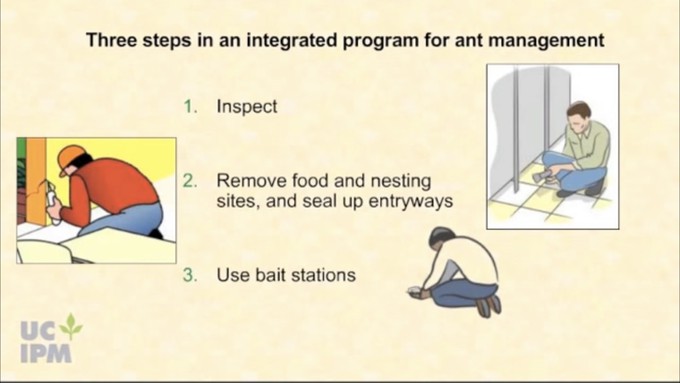
Rain, cold can send ants indoors

This is a screenshot from one of UCIPM's short videos on managing ants. Longer ones also are viewable on YouTube. Screenshot from UCIPM video "How to effectively control ants."
The first ones showed up on a shelf in the spice cabinet. They were easily dispatched. Then a few more appeared along the cupboard above the refrigerator, which is next to the coffee bar. They were easily removed, too, but I decided to relocate the just-refilled sugar bowl across the kitchen.
You know what happened next, right? The following day some intrepid ants had found the sugar bowl, and there was a thin line of their colleagues along the edge of the ceiling and down to the counter where the sugar now was. The battle was on.
With all the rain we’ve had, it’s a wonder the ants hadn’t invaded sooner. But these – very likely common Argentine ants – apparently were driven inside by the low-30s temperatures we’ve had this past week.
Fortunately, some quick work interrupted their incursion and they haven’t reappeared. (Knock on wood!) But it’s a good reminder that not every insect is dormant in winter. Pests live among us year-round, and it helps to be vigilant without resorting to overkill, i.e. pesticides.
The University of California Integrated Pest Management program offers a wealth of information on dealing with household and garden pests. UCIPM has pages and pages devoted to ants on the website, as well as several YouTube videos – quick 1-minute hits as well as longer explainers.
Part of the defense against ants indoors should be to remove whatever’s attracting them – pet food, cookie crumbs, (ahem) sugar bowl – then wipe the ants up with a soapy cloth or sponge, or use window cleaner. This destroys the trail being left for other ants. Also, try to find where they’re coming from outside, and caulk or block the entrance. Ant traps left near entrances will slow them down, though IPM experts note that it may take a week or so for traps to work. They caution against spraying for ants inside the home.
UC IPM presents a monthly Urban and Community Webinar on pest topics; past ones are recorded for later viewing. (Ants were discussed in October 2021.)
Here are the pest topics through April, all scheduled for noon to 1 p.m. Register at the Webinar link above to view them live.
Thursday, Feb. 16, “Dealing With Pantry Pests.”
Thursday, March 16, “Preventing Pest Problems at Seeding.”
Thursday, April 20, “Aphids, Scales and Mealybugs, Oh My.”
Meanwhile I’m on watch against future invaders – and replacing the sugar bowl with one featuring an airtight seal.
Comments
0 comments have been posted.Sacramento Digs Gardening to your inbox.
Food in My Back Yard Series
April 1: Don't be fooled by these garden myths
March 25: Fertilizer tips: How to 'feed' your vegetables for healthy growth
March 18: Time to give vegetable seedlings some more space
March 11: Ways to win the fight against weeds
March 4: Potatoes from the garden
Feb. 25: Plant a fruit tree now -- for later
Feb. 18: How to squeeze more food into less space
Feb. 11: When to plant? Consider staggering your transplants
Feb. 4: Starting in seed starting
Sites We Like
Garden Checklist for week of March 30
Your garden doesn’t mind April showers. Get busy now to enjoy those future flowers.
* Get ready to swing into action in the vegetable garden. As nights warm up over 50 degrees, start setting out tomato, pepper and eggplant transplants.
* From seed, plant beans, beets, cantaloupes, carrots, corn, cucumbers, melons, pumpkins, radishes and squash. (Soak beet seeds overnight in water for better germination,)
* Plant onion sets.
* In the flower garden, plant seeds for asters, cosmos, celosia, marigolds, salvia, sunflowers and zinnias.
* Transplant petunias, zinnias, geraniums and other summer bloomers.
* Plant perennials and dahlia tubers for summer bloom.
* Transplant lettuce and cabbage seedlings.
* April is the last chance to plant citrus trees such as dwarf orange, lemon and kumquat. These trees also look good in landscaping and provide fresh fruit in winter.
* Smell orange blossoms? Feed citrus trees with a low dose of balanced fertilizer (such as 10-10-10) during bloom to help set fruit. Keep an eye out for ants.
* Apply slow-release fertilizer to the lawn.